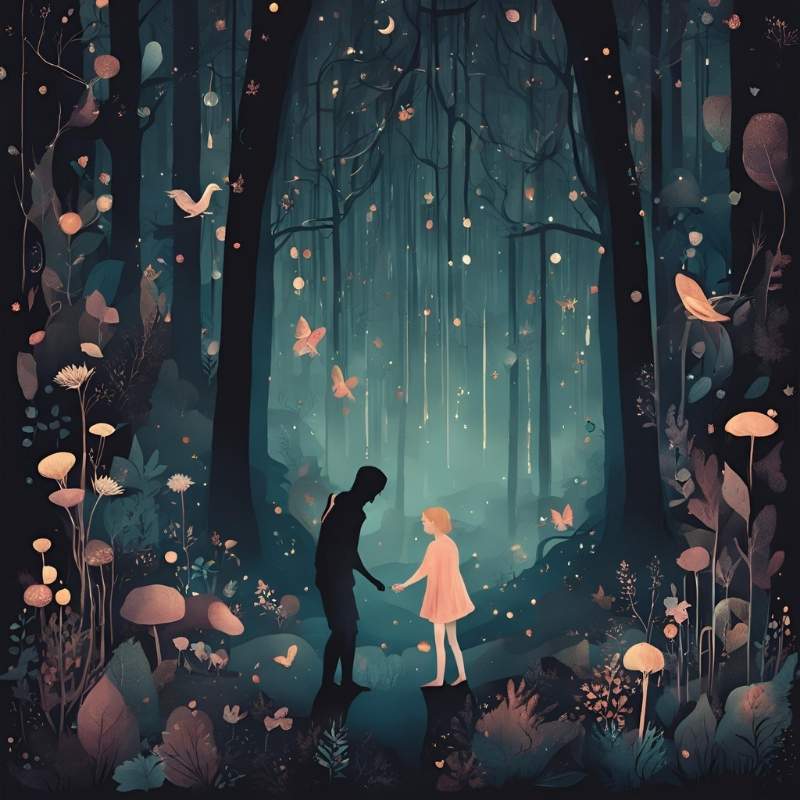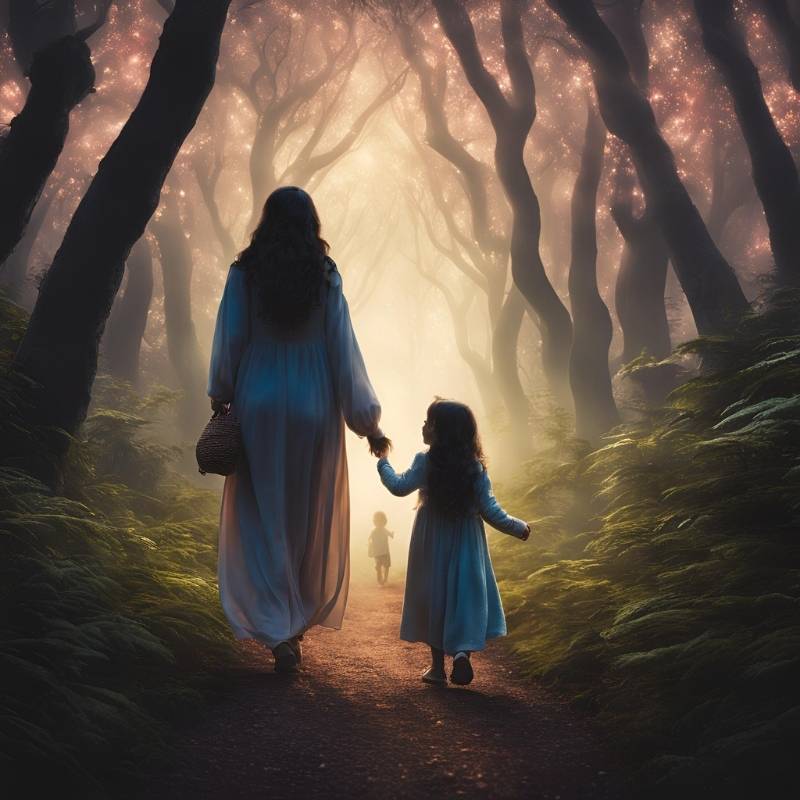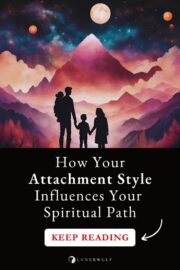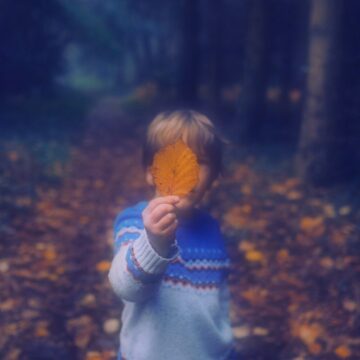Here’s a quick question for you:
Are you the kind of person who tends to run away from relationships with others, get overly invested in them, or a little bit of both? Perhaps you generally feel fine in relationships?
Your answer to this simple question reveals what type of attachment style you have.

Spiritual Wanderer Course:
⭐️⭐️⭐️⭐️⭐ "I started the Spiritual Wanderers Course a short while ago and for the first time in twelve years I have started to experience love, acceptance and compassion for myself and within myself. Thank you so much." – Vivienne S.
In psychology, an attachment style is a pattern of behavior that we develop in response to the relationship we have with our primary caregivers. There are four types: secure, anxious, avoidant, and disorganized.
If you tend to isolate or distance yourself from others, you likely have an avoidant attachment style. On the other hand, if you tend to fear abandonment and need intense closeness, you likely have an anxious attachment style.
If you have a mixture of these two types, you have a disorganized attachment style. And if you feel generally grounded and relaxed in your relationships, congratulations, you have a secure attachment style.
These are broad, sweeping statements, I know. Attachment styles are much more complex than I make them out to be (for instance, we all have a little bit of each type, to varying degrees).
So why am I bringing this topic up?
The reality is that, unless we live on a totally isolated island in the middle of the ocean, relating to other people is a major part of daily life. It is the fabric that tends to bind our days together.
And as a species wired to be social, our connections with others often form our very best and worst experiences in life.
Not only that, but there is a spiritual element to attachment styles. Your attachment style (secure, anxious, avoidant, or disorganized) also directly influences your connection with your Soul, Higher Self, Source, Spirit, or whatever you call the Divine.
If you have any one of the three insecure attachment styles – whether that be avoidant, anxious, or disorganized – you have wounding and trauma surrounding connection.
In this post, I’m going to share a few thoughts on the overlap between your attachment style and your spiritual path, as well as how to find a way back to building a ‘secure base’ with others and Life.
Table of contents
The Four Attachment Styles – Which One Are You?

The theory of attachment styles was first developed by psychoanalyst and psychiatrist John Bowlby back in the 1950s and 1960s.
It was later expanded upon by developmental psychologist Mary Ainsworth, who explored how important it was for us to develop a “secure base” with our primary caregivers as children.
If we were never provided a secure base – that is, a parental figure who was sensitive to our needs, attentive, loving, and provided us with a safe haven – then we developed one of the following attachment styles:
Anxious Attachment
Also known as Anxious-Ambivalent or Anxious-Preoccupied. Characterized by:
- Fearing abandonment
- People-pleasing tendencies
- Low self-esteem
- Struggling to trust others
- Clinginess/codependency in relationships
- Scared of rejection of any kind
- Difficulty being alone
- Jealous tendencies
- Feeling unworthy of love
Avoidant Attachment
Characterized by:
- Difficulty trusting others
- Feeling threatened by closeness
- Struggling to express emotions
- Avoiding mental/emotional intimacy
- Seeking out solitude to the extreme
- Extremely independent and individualistic
- Dismissing others’ strong feelings
- Fearing commitment
Disorganized Attachment
Characterized by a blend of anxious and avoidant attachment style traits, such as:
- Wanting closeness but fearing it (playing “push and pull” games)
- Self-isolating tendencies
- Difficulty regulating emotions
- “Trust issues”
- Anxiety surrounding commitment
- Unpredictable behavior
- Going to extremes: aloofness, then clinginess
- Poor communication skills
- Negative view themselves and others
Which one of the above do you relate to the most?
Would you like to save this?
Your information will never be shared.
If you’d like a place to work through some of the above issues, see our Shadow & Light offering. It offers a secure external base if you’re a spiritual seeker needing ongoing support, run by two earned, securely attached guides (Mateo and myself).
If you were raised by physically, mentally, and emotionally attentive caregivers, you would have likely developed a secure attachment style that is defined by the following:
Secure Attachment Style
Characterized by:
- Comfortable being alone and with others
- Able to trust others easily
- Healthy self-esteem
- Ability to regulate emotions
- Handles conflict well
- Emotionally available
- Good communication skills
- Does well in close relationships
The Overlap Between Spirituality and Attachment Style

“Attachment is a unifying principle that reaches from the biological depths of our being to its furthest spiritual reaches.” – Jeremy Holmes
The attachment style you develop is reflected in every single one of your relationships, including your relationship with Soul and Spirit. Why wouldn’t it?
Suppose you were raised with neglectful caregivers and developed an avoidant attachment style that encouraged you to be overly self-reliant and individualistic (as a form of self-protection). Why wouldn’t that way of relating also influence your spiritual connection?
If you were raised with emotionally inconsistent caretakers and developed an anxious attachment style, why wouldn’t that way of relating also distort your relationship with your spiritual path?
Right now, you might be curious how your attachment style impacts your spiritual journey. Here is a quick and basic breakdown:
Anxious Attachment & Spirituality
- Desperately seeks a spiritual connection to fulfill every need
- Feels easily abandoned by the Divine/Life/God
- Tendency towards fundamentalism and finding the “one true answer/path”
- Worries about becoming distant or separated from one’s spiritual teacher, guru, or spiritual calling
- Finds a sense of self-identity in the spiritual quest or a spiritual group
- Prone to experiencing spiritual fundamentalism and spiritual abuse
Avoidant Attachment & Spirituality
- Feels threatened by spiritual processes, paths, and topics
- Tends to be cynical and mistrusting
- Once they embrace spirituality, adopts a “left-brain” approach of trying to understand, study, and know all there is to know about the Divine/Life/God
- Avoids emotional openness and availability
- Difficulty connecting to the Divine on a deeper level
- Prefers doing rather than feeling or being
- Scared of losing a sense of individuality and autonomy (aka., “being trapped”)
Disorganized Attachment & Spirituality
- Craves for spiritual connection but fears and avoids it due to trust issues
- Fear of spiritual abandonment
- Believes that they’re not “good enough” to experience a true spiritual connection
- Has a hard time accepting or asking for help from spiritual teachers and guides
- Struggles to commit to one path and jumps around as a “spiritual tourist” without ever going that deep
- Adopt a “push and pull” connection with their spirituality, wanting it at some points and rejecting it at other points
Secure Attachment & Spirituality
- Feels a sense of trust and openness towards Divine/Life/God
- Has a high level of spiritual discernment (less prone to spiritual abuse)
- Able to seek out and give spiritual support
- Develops a consistent spiritual practice maintained each day
- Feels secure in and out of spiritual communities
- Has a “secure base,” knowing they are loved by Divine/Life/God no matter what
- Trusts in the wisdom of higher powers
- Are open to growing/changing their spiritual perspectives and views
- Becomes more deeply resilient as a result of their spiritual practice/path
How to Develop a Secure Base (3 Ways)

“Life is best organized as a series of daring ventures from a secure base.” – John Bowlby
I took an attachment style test the other day (I wish I remembered where), and to my surprise, I saw that I ranked as primarily secure attachment style, followed by avoidant, and then disorganized and anxious.
If I were to take that same test maybe five or more years ago, I’m sure I would have been primarily avoidant. But through time, the establishment of a healthy relationship, and a lot of inner work, I’ve achieved something known as earned secure attachment.
Earned secure attachment is what happens when you start life with one of the insecure attachment styles (anxious, avoidant, or disorganized). But through embarking on a journey of mental, emotional, and spiritual healing, you eventually learn how to develop an inner secure base.
In attachment theory, a ‘secure base’ initially refers to a person, in this case, the main caregiver that we had as a child. This caregiver is meant to provide a safe and secure environment on an outer and inner level. If they do this successfully, they create a ‘secure base’ for us.
But developing a secure base as an insecure adult isn’t about regressing to childhood and trying to get our caregivers to fulfill our unmet needs.
Instead, it’s about developing a secure base through our relationships with other secure individuals and within the context of our spiritual path.
Here are some ideas to help you learn how to develop a secure base, which have all helped me through the years:
1. Find a secure person to connect with and be aware of your current attachments

Read the signs of someone with a secure attachment style above and burn them into your brain. Be on the lookout for these types of people. More easily, you can find secure attachments often in the form of therapists, coaches, and spiritual guides (we offer a great space for that here).

Spiritual Awakening Bundle:
⭐️⭐️⭐️⭐️⭐ "Luna & Sol, your words have been like salve to my soul. I have been searching for a way to heal and reconnect to my true self for so long (20 years) but have never found anything that truly made a difference… Until I read your books." – Stac
If finding a secure partner or friendship is not in the cards, connecting with these types of professionals can be extremely beneficial. Sometimes, our pets can even be sources of secure attachment (provided that they’re not aloof or clingy).
Also, be aware of your current attachments. Who do you connect with regularly? What type of attachment style exists between you and the other person?
Think about what boundaries you need to set internally and externally. Boundaries give you a breathing space to listen to your needs and honor them.
2. Take time each day to connect with the ‘heart’ of awareness

Beneath the clutter and noise of the mind is a space of pure awareness.
Some call this space Consciousness, Luminous Presence, the Sky of Awareness, Spirit, Source, Soul, the Shimmering Void, and the Divine heart. Find your own name for it through a practice like meditation.
I find that imagery helps me to connect with this pure space – this safe and secure base that is ever-present and always there for us.
Try any of the following imagery:
- See yourself as the sky and your thoughts as clouds
- Visualize the awareness within you as a shimmering night sky
- Sense this space within you as a ‘backdrop’ to everything happening in the forefront of your mind
- Notice the open space of awareness behind your eyes and proceeding thought
The more you return to this primordial secure base, the more grounded and at home you will feel within yourself and your life.
3. Connect with your Divine Inner Parent

The Divine Inner Parent is an aspect of your Soul – an archetypal force within you that is an expression of your heart’s presence.
Your Divine Inner Parent could be a mother or father figure or perhaps a gender-neutral ‘parent’ who loves, delights in, and cherishes you.
This practice overlaps with inner child work, and I find that it has been one of the most powerful ways I’ve learned to develop a secure base in my entire journey.
Journal, practice mirror work, and meditate with this figure on a regular basis.
I also recommend that you find a role model or image of a Divine Parent that speaks to you deeply that you can use as a spiritual guide and ally.
For me, that was the Divine Mother in the form of Tara, Quan Yin, and Mother Mary. Find whatever imagery appeals most to you.
***
If you have a connection wound, you were raised with caregivers who were inconsistent, neglectful, or unsafe in some way.
Learning about your attachment style not only helps you to find more balance in your relationships, but it also helps you to develop a healthier, more fulfilling connection with Soul and Spirit.
Tell me, what is your attachment style? How does it impact your connections with others and your spiritual path as a whole? I’d love to hear from you below.
If you need more help, we offer 3 powerful ways to guide you on your inner journey:
1. The Spiritual Wanderer Course: Feeling lost or uncertain about your path and purpose in life? Gain clarity and focus by learning about the five archetypes of awakening within you. Discover your deeper path and purpose using our in-depth psychospiritual map. Includes 3+ hours of audio-visual content, workbooks, meditations, and a premium test.
2. Shadow & Light Membership: Seeking ongoing support for your spiritual journey? Receive weekly intuitive guidance and learn to embrace your whole self, including your shadow side. Deepen your self-love and receive personal support from us.
3. Spiritual Awakening Bundle: Ready to soul search and dive deep? Access our complete "essentials" collection of beloved journals and eBooks. Includes five enlightening eBooks and seven guided journals, plus two special bonuses to further illuminate your path.










This is such an intriguing perspective! It explains a lot. (I’m disorganized so sometimes I’ll talk to Spirit all day long and worry that I’ve been abandoned, other days I feel like I’m being bothersome and need to figure things out on my own so I don’t reach out for days on end 😅 silly, I know.) I admire the way you always combine spirituality and psychology in such a practical way. My brain works this way too, but it’s hard to find others who see the connections rather than the contrasts. Usually people insist that it’s one “or” the other. Your work is refreshing among so much spiritual fluff on the internet. Thank you Luna, much love to you 🐺